Page 127 of 256
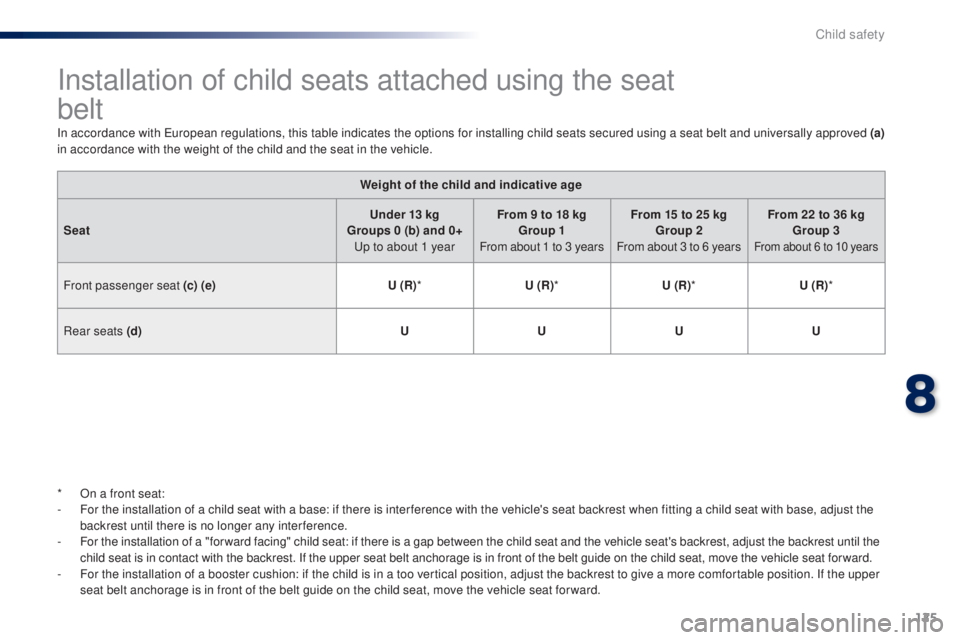
125
Installation of child seats attached using the seat
belt
In accordance with european regulations, this table indicates the options for installing child seats secured using a seat belt and universally approved (a)
in accordance with the weight of the child and the seat in the vehicle.
Weight of the child and indicative age
Seat Under 13 kg
Groups 0 (b) and 0+
up t
o about 1 yearFrom 9 to 18 kg
Group 1
From about 1 to 3 years From 15 to 25 kg
Group 2
From about 3 to 6 years From 22 to 36 kg
Group 3
From about 6 to 10 years
Front passenger seat (c) (e) U (R)* U (R)* U (R)* U (R)*
Rear seats (d) UUUU
*
O
n a front seat:
-
F
or the installation of a child seat with a base: if there is inter ference with the vehicle's seat backrest when fitting a child seat with base, adjust the
backrest until there is no longer any interference.
-
F
or the installation of a "for ward facing" child seat: if there is a gap between the child seat and the vehicle seat's backrest, adjust the backrest until the
child seat is in contact with the backrest. If the upper seat belt anchorage is in front of the belt guide on the child seat, move the vehicle seat for ward.
-
F
or the installation of a booster cushion: if the child is in a too vertical position, adjust the backrest to give a more comfortable position. If the upper
seat belt anchorage is in front of the belt guide on the child seat, move the vehicle seat for ward.
8
Child safety
Page 128 of 256
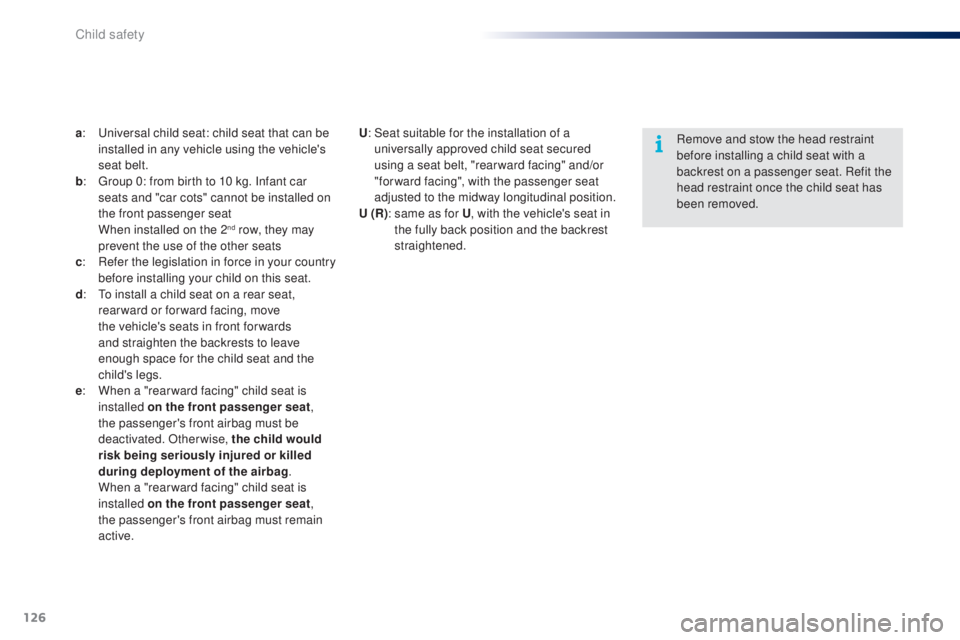
126
a: universal child seat: child seat that can be installed in any vehicle using the vehicle's
seat belt.
b :
g
r
oup 0: from birth to 10 kg. Infant car
seats and "car cots" cannot be installed on
the front passenger seat
W
hen installed on the 2
nd row, they may
prevent the use of the other seats
c :
R
efer the legislation in force in your country
before installing your child on this seat.
d :
t
o i
nstall a child seat on a rear seat,
rear ward or for ward facing, move
the vehicle's seats in front for wards
and straighten the backrests to leave
enough space for the child seat and the
child's
legs.
e :
W
hen a "rear ward facing" child seat is
installed on the front passenger seat ,
the passenger's front airbag must be
deactivated. Otherwise, the child would
risk being seriously injured or killed
during deployment of the airbag .
W
hen a "rear ward facing" child seat is
installed on the front passenger seat ,
the passenger's front airbag must remain
active. Remove and stow the head restraint
before installing a child seat with a
backrest on a passenger seat. Refit the
head restraint once the child seat has
been removed.
U
:
S
eat suitable for the installation of a
universally approved child seat secured
using a seat belt, "rear ward facing" and/or
"forward facing", with the passenger seat
adjusted to the midway longitudinal position.
U (R) :
s
ame as for U
, with the vehicle's seat in
the fully back position and the backrest
straightened.
Child safety
Page 129 of 256
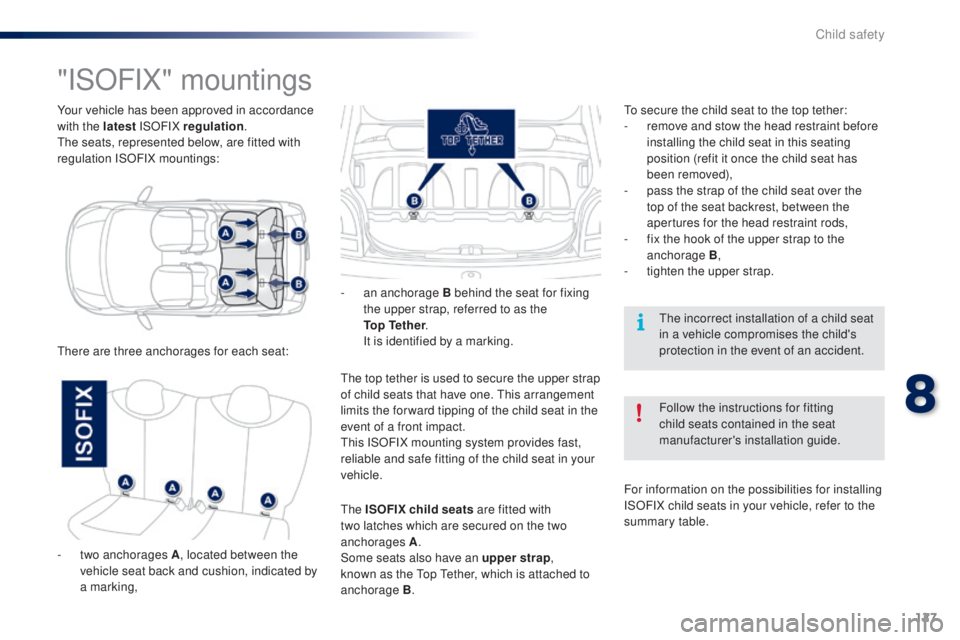
127
Your vehicle has been approved in accordance
with the latest ISOFIX regulation .
th
e seats, represented below, are fitted with
regulation ISOFIX mountings:
"ISOFIX" mountings
there are three anchorages for each seat: -
an
anchorage B behind the seat for fixing
the upper strap, referred to as the
Top Tether . I t is identified by a marking.
th
e top tether is used to secure the upper strap
of child seats that have one.
t
h
is arrangement
limits the for ward tipping of the child seat in the
event of a front impact.
th
is ISOFIX mounting system provides fast,
reliable and safe fitting of the child seat in your
vehicle. Follow the instructions for fitting
child seats contained in the seat
manufacturer's installation guide.
th
e incorrect installation of a child seat
in a vehicle compromises the child's
protection in the event of an accident.
th
e ISOFIX child seats are fitted with
two latches which are secured on the two
anchorages A .
Some seats also have an upper strap ,
known as the
t
o
p t
e
ther, which is attached to
anchorage B .
to s
ecure the child seat to the top tether:
-
r
emove and stow the head restraint before
installing the child seat in this seating
position (refit it once the child seat has
been removed),
-
p
ass the strap of the child seat over the
top of the seat backrest, between the
apertures for the head restraint rods,
-
f
ix the hook of the upper strap to the
anchorage B ,
-
t
ighten the upper strap.
For information on the possibilities for installing
ISOFIX child seats in your vehicle, refer to the
summary table.
-
t
wo anchorages A , located between the
vehicle seat back and cushion, indicated by
a marking,
8
Child safety
Page 130 of 256
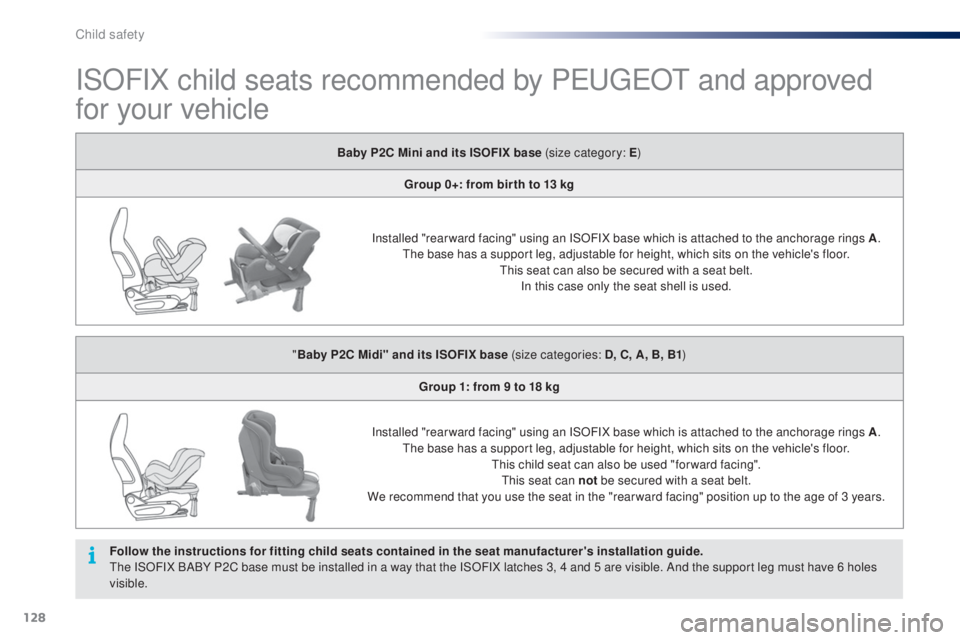
128
ISOFIX child seats recommended by PeugeOt and approved
for your vehicle
Baby P2C Mini and its ISOFIX base (size category: E )
Group 0+: from bir th to 13 kg
Installed "rear ward facing" using an ISOFIX base which is attached to the anchorage rings A .
th
e base has a support leg, adjustable for height, which sits on the vehicle's floor.
th
is seat can also be secured with a seat belt. In this case only the seat shell is used.
" Baby P2C Midi" and its ISOFIX base (size categories: D, C, A, B, B1 )
Group 1: from 9 to 18 kg
Installed "rear ward facing" using an ISOFIX base which is attached to the anchorage rings A .
th
e base has a support leg, adjustable for height, which sits on the vehicle's floor.
th
is child seat can also be used "for ward facing".
th
is seat can not be secured with a seat belt.
We recommend that you use the seat in the "rear ward facing" position up to the age of 3 years.
Follow the instructions for fitting child seats contained in the seat manufacturer's installation guide.
th
e ISOFIX BABY P2C base must be installed in a way that the ISOFIX latches 3, 4 and 5 are visible. And the support leg must have 6 holes
visible.
Child safety
Page 131 of 256
129
"RÖMER Baby- Safe Plus and its Baby- Safe Plus ISOFIX base" (size category: E)
Group 0+: from bir th to 13 kg
Installed "rear ward facing" using an ISOFIX base which is attached to the rings A .
th
e base has a support leg, adjustable for height, which sits on the vehicle's floor.
th
is child seat can also be secured with a seat belt. In this case, only the shell is used and attached to the vehicle's seat by the three-point seat belt.
Follow the instructions for fitting child seats contained in their manufacturer's installation guide.
8
Child safety
Page 134 of 256
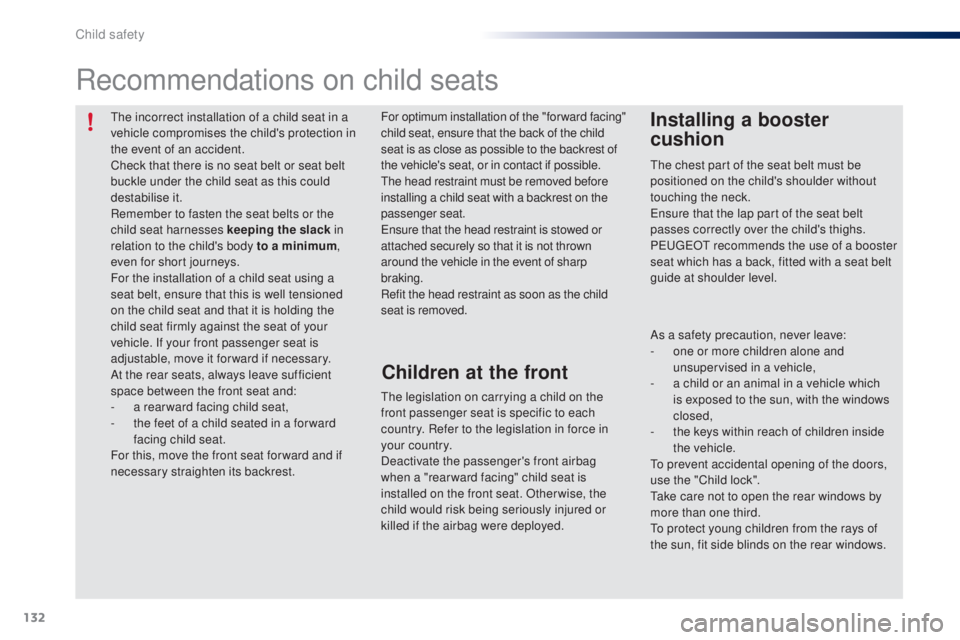
132
the incorrect installation of a child seat in a
vehicle compromises the child's protection in
the event of an accident.
Check that there is no seat belt or seat belt
buckle under the child seat as this could
destabilise it.
Remember to fasten the seat belts or the
child seat harnesses keeping the slack in
relation to the child's body to a minimum,
even for short journeys.
For the installation of a child seat using a
seat belt, ensure that this is well tensioned
on the child seat and that it is holding the
child seat firmly against the seat of your
vehicle. If your front passenger seat is
adjustable, move it forward if necessary.
At the rear seats, always leave sufficient
space between the front seat and:
-
a r
ear ward facing child seat,
-
t
he feet of a child seated in a for ward
facing child seat.
For this, move the front seat for ward and if
necessary straighten its backrest.
Recommendations on child seats
the chest part of the seat belt must be
positioned on the child's shoulder without
touching the neck.
en
sure that the lap part of the seat belt
passes correctly over the child's thighs.
P
e
uge
Ot
recommends the use of a booster
seat which has a back, fitted with a seat belt
guide at shoulder level.
As a safety precaution, never leave:
-
o
ne or more children alone and
unsupervised in a vehicle,
-
a c
hild or an animal in a vehicle which
is exposed to the sun, with the windows
closed,
-
t
he keys within reach of children inside
the vehicle.
to p
revent accidental opening of the doors,
use the "Child lock".
ta
ke care not to open the rear windows by
more than one third.
to p
rotect young children from the rays of
the sun, fit side blinds on the rear windows.
th
e legislation on carrying a child on the
front passenger seat is specific to each
country. Refer to the legislation in force in
your country.
Deactivate the passenger's front airbag
when a "rear ward facing" child seat is
installed on the front seat. Otherwise, the
child would risk being seriously injured or
killed if the airbag were deployed. For optimum installation of the "forward facing"
child seat, ensure that the back of the child
seat is as close as possible to the backrest of
the vehicle's seat, or in contact if possible.
th
e head restraint must be removed before
installing a child seat with a backrest on the
passenger seat.
en
sure that the head restraint is stowed or
attached securely so that it is not thrown
around the vehicle in the event of sharp
braking.
Refit the head restraint as soon as the child
seat is removed.
Installing a booster
cushion
Children at the front
Child safety
Page 138 of 256
136
Complete system consisting of a compressor
and a sealant cartridge which permits
temporary repair of a tyre so that you can
drive to the nearest garage.
It is designed to repair most punctures which
could affect the tyre, located on the tyre tread
or shoulder.
temporary puncture repair kit
Composition of the kit
1. 12 V compressor, with integral pressure gauge.
2.
S
ealant cartridge, with integral hose.
3.
Spe
ed limit sticker.
th
e speed limit sticker must be secured
to the interior of the vehicle in the
driver's field of vision, to remind you
that a wheel is in temporary use.th
is kit is installed in the storage box, under the
boot floor.
th
e vehicle's electric system allows the
connection of a compressor for long
enough to inflate a tyre after a puncture
repair or for inflating a small inflatable
accessory.
Do not exceed a speed of 50 mph
(80
km/h) when driving with a tyre
repaired using this type of kit.
Access to the kit
Practical information
Page 139 of 256
137
F uncoil the pipe stowed under the compressor.
F
C
onnect the pipe from the compressor to
the sealant cartridge.
F
t
u
rn the the sealant cartridge and secure it
in the cut-out provided on the compressor.
Repair procedure
Avoid removing any foreign bodies
which have penetrated into the tyre. F
R
emove the valve cap from the tyre to be
repaired, and place it in a clean area.
F
C
onnect the hose from the sealant
cartridge to the valve of the tyre to be
repaired and tighten firmly.
F
S
witch off the ignition.
F
S
ecure the speed limit sticker inside the
vehicle.
9
Practical information